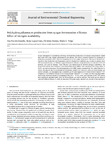Polyhydroxyalkanoates Production From Syngas Fermentation Effluents: Effect of Nitrogen Availability

Ver/abrir
Use este enlace para citar
http://hdl.handle.net/2183/29981
A non ser que se indique outra cousa, a licenza do ítem descríbese como Atribución-NoComercial-SinDerivadas 4.0 Internacional
Coleccións
- Investigación (FCIE) [1237]
Metadatos
Mostrar o rexistro completo do ítemTítulo
Polyhydroxyalkanoates Production From Syngas Fermentation Effluents: Effect of Nitrogen AvailabilityData
2021-10-29Cita bibliográfica
A. Portela-Grandío, B. Lagoa-Costa, C. Kennes, M.C. Veiga, Polyhydroxyalkanoates production from syngas fermentation effluents: Effect of nitrogen availability, Journal of Environmental Chemical Engineering. 9 (2021) 106662. https://doi.org/10.1016/j.jece.2021.106662
Resumo
[Abstract] Syngas fermentation is a promising technology for bioalcohols production even though some produced volatile fatty acids (VFA) may remain unconsumed in the effluent. The present research explored the production of polyhydroxyalkanoates (PHA) from the remaining VFA of the syngas fermentation effluents in fed-batch bioreactors so that bioalcohols and biopolymers could be obtained in a combined way. In order to perform these PHA accumulation tests, two different syngas fermentation effluents, composed mainly of a mixture of VFA and alcohols, were used as substrate. Those effluents were characterized by different nitrogen availabilities, one being N-rich and the other N-limited. A mixed microbial culture (MMC) with a maximum PHA storage ability of 53.6% was used as inoculum. The microorganisms of the MMC mainly consumed the VFA rather than the alcohols, allowing the latter to accumulate as end product, besides PHA. However, when the N-rich effluent was used as substrate, the consumption rate of alcohols was 20 times higher (0.040 Cmmol-Alcohol Cmmol-X-1 h-1) compared to the N-limited effluent (0.002 Cmmol-Alcohol Cmmol-X-1 h-1). Despite not observing large differences in the maximum amount of accumulated PHA (40.5 – 41.5%), there was a decrease in the PHA content after reaching its maximum peak when the N-rich effluent was used as substrate. This trend was not observed with the N-limited effluent, in which the maximum PHA peak exactly matched with the end of the experiment.
Palabras chave
Aerobic dynamic feeding
Biopolymer
Cheese whey
Hydroxyhexanoate
Mixed cultures
Syngas
Biopolymer
Cheese whey
Hydroxyhexanoate
Mixed cultures
Syngas
Descrición
Financiado para publicación en acceso aberto: Universidade da Coruña/CISUG
Versión do editor
Dereitos
Atribución-NoComercial-SinDerivadas 4.0 Internacional
ISSN
2213-3437






